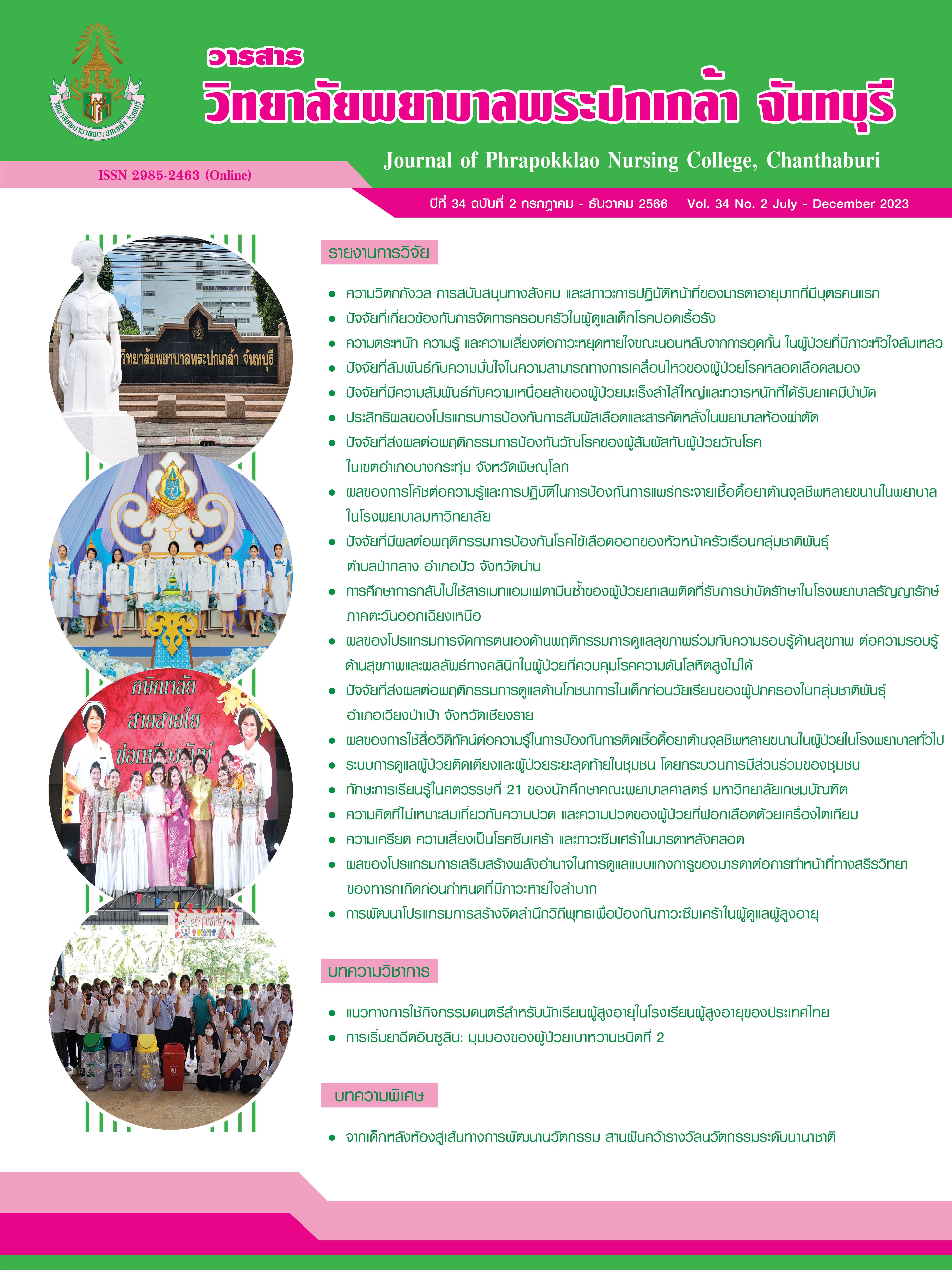Pain Catastrophizing and Pain in Hemodialysis Patients
Keywords:
Pain catastrophizing, Pain, HemodialysisAbstract
This cross-sectional descriptive research aimed to study pain catastrophizing and pain in hemodialysis patients. The samples consisted of 85 chronic renal patients with hemodialysis in Chanthaburi Province. The research instruments were composed of the personal data questionnaire, the Pain Catastrophizing Scale with a reliability of .87, and the Thai version short-form McGill Pain Questionnaire with a reliability of .78. Data were collected from October to November 2021. Statistics used for data analysis included frequency, percentage, mean, standard deviation, median, interquartile range, and Spearman rank correlation.
The research results revealed that 1) both before and after hemodialysis, most hemodialysis patients were non extreme catastrophizer group (97.60%), while all of them had pain score at a mild level (100%); and 2) both before and after hemodialysis, pain catastrophizing was positively statistically significantly related to pain in hemodialysis patients (rs = .920, p < .001 and rs = .930, p < .001, respectively).
This research suggests that medical personnel who care for hemodialysis patients should assess pain catastrophizing and pain in hemodialysis patients periodically in order to provide information on caring for hemodialysis patients.
References
กันตพร ยอดใชย. (2562). ผู้ป่วยโรคไตเรื้อรัง: การพยาบาลและการจัดการอาการ. สงขลา: พี ซี โปรสเปค.
เกษร เกษมสุข, และบังอร ฤทธิ์อุดม. (2566). การส่งเสริมพัฒนาการผู้ใหญ่วัยกลางคน: บทบาทของพยาบาล. วารสารศูนย์อนามัยที่ 9: วารสารส่งเสริมสุขภาพและอนามัยสิ่งแวดล้อม, 17(1), 368–380.
คณะอนุกรรมการลงทะเบียนการบำบัดทดแทนไต สมาคมโรคไตแห่งประเทศไทย. (2563). Thailand renal replacement therapy: Year 2020. สืบค้นจาก https://www.nephrothai.org/wp-content/uploads/2022/06/Final-TRT-report-2020.pdf
คณะอนุกรรมการกำหนดแนวทางการรักษาด้วยการฟอกเลือดและการกรองพลาสมา สมาคมโรคไตแห่งประเทศไทย. (2561). คู่มือการรักษาด้วยการฟอกเลือดและการกรองพลาสมาสำหรับผู้ป่วยโรคไต พ.ศ. 2561. สืบค้นจาก https://www.nephrothai.org/wp-content/uploads/2021/10/คู่มือการรักษาด้วยการฟอกเลือดและการกรองพลาสมาสำหรับผู้ป่วยโรคไต-2561.pdf
จันทรา เริ่มเสริมสุข. (2563). ประสิทธิผลของการประคบความเย็นต่อความปวดจากการแทงเข็ม AVF ในผู้ป่วยโรคไตเรื้อรังระยะสุดท้ายที่รับการรักษาโดยการฟอกเลือดด้วยเครื่องไตเทียม โรงพยาบาลดำเนินสะดวก จังหวัดราชบุรี. วารสารหัวหินสุขใจไกลกังวล, 5(2), 28–38.
ทิพวัลย์ เรืองฤทธิ์, และวัชริน สินธวานนท์. (2561). มุมมองต่อความปวดของผู้ป่วยไทยที่ปวดเรื้อรัง. วิสัญญีสาร, 44(3), 127–135.
ยศพล เหลืองโสมนภา, นุสรา ประเสริฐศรี, ชวนชม พืชพันธ์ไพศาล, ลลิตา เดชาวุธ, และพิมพ์รัตน์ โทกุล. (2563). โมเดลการวัดของแบบวัดความคิดที่ไม่เหมาะสมเกี่ยวกับความปวดฉบับภาษาไทย. วารสารวิทยาลัยพยาบาลพระปกเกล้า จันทบุรี, 31(1), 33–42.
ยศพล เหลืองโสมนภา, นุสรา ประเสริฐศรี, พัชราภัณฑ์ ไชยสังข์, วารุณี สุวรวัฒนกุล, และปัญญา สนั่นพานิชกุล. (2558). ความคิดที่ไม่เหมาะสมเกี่ยวกับความปวด : แนวคิดและการนำไปใช้ในการวิจัยความปวดในประเทศไทย. วารสารศูนย์การศึกษาแพทยศาสตร์คลินิก โรงพยาบาลพระปกเกล้า, 32(3), 256–269.
วราภรณ์ ภูคา, นพพร ว่องสิริมาศ, และวารีรัตน์ ถาน้อย. (2563). ปัจจัยที่มีความสัมพันธ์กับสุขภาวะทางจิตใจในผู้ป่วยที่ฟอกเลือดด้วยเครื่องไตเทียม. วารสารพยาบาลศาสตร์, 38(1), 73–85.
วสุวัฒน์ กิติสมประยูรกุล, จักรกริช กล้าผจญ, และอภิชนา โฆวินทะ. (2547). แบบประเมินความเจ็บปวด Short-form McGill Pain Questionnaire ฉบับภาษาไทย. เวชศาสตร์ฟื้นฟูสาร, 14(3), 83–92.
Dos Santos, P. R., Mendonça, C. R., Noll, M., Borges, C. C., Alves, P. M., Dias, N. T., … Porto, C. C. (2021). Pain in hemodialysis patients: Prevalence, intensity, location, and functional interference in daily activities. Healthcare, 9(10), 1375. doi:10.3390/healthcare9101375
Fleishman, T. T., Dreiher, J., & Shvartzman, P. (2018). Pain in maintenance hemodialysis patients: A multicenter study. Journal of Pain and Symptom Management, 56(2), 178–184. doi:10.1016/j.jpainsymman.2018.05.008
Gerogianni, G. (2023). Factors affecting pain in hemodialysis and non-pharmacological management. Cureus, 15(2), e35448. doi:10.7759/cureus.35448
Hirata, J., Tomiyama, M., Koike, Y., Yoshimura, M., & Inoue, K. (2021). Relationship between pain intensity, pain catastrophizing, and self-efficacy in patients with frozen shoulder: A cross-sectional study. Journal of Orthopaedic Surgery and Research, 16(1), 542. doi:10.1186/s13018-021-02693-y
Ibrahim, A. A., Akindele, M. O., Kaka, B., & Mukhtar, N. B. (2021). Development of the Hausa version of the Pain Catastrophizing Scale: Translation, cross-cultural adaptation and psychometric evaluation in mixed urban and rural patients with chronic low back pain. Health and Quality of Life Outcomes, 19(1), 44. doi:10.1186/s12955-020-01644-1
Kurien, T., Kerslake, R. W., Graven-Nielsen, T., Arendt-Nielsen, L., Auer, D. P., Edwards, K., … Petersen, K. K. (2022). Chronic postoperative pain after total knee arthroplasty: The potential contributions of synovitis, pain sensitization and pain catastrophizing–An explorative study. European Journal of Pain, 26(9), 1979–1989. doi:10.1002/ejp.2018
Latifi, Z., & Kiani, M. (2021). The multiple relationships between anxiety sensitivity, social support, perception of pain and life expectancy variables. Journal of Research & Health, 11(2), 87–94. doi:10.32598/JRH.11.2.1598.3
Melzack, R., Wall, P. D., & Ty, T. C. (1982). Acute pain in an emergency clinic: Latency of onset and descriptor patterns related to different injuries. Pain, 14(1), 33–43. doi:10.1016/0304-3959(82)90078-1
Miot, H. A. (2011). Sample size in clinical and experimental trials. Jornal Vascular Brasileiro, 10(4), 275–278. Retrieved from https://www.scielo.br/j/jvb/a/Dxg84WBMPnNrVcpKMXyVfHd/?format=pdf&lang=en
Murray, C. B., Patel, K. V., Twiddy, H., Sturgeon, J. A., & Palermo, T. M. (2021). Age differences in cognitive–affective processes in adults with chronic pain. European Journal of Pain, 25(5), 1041–1052. doi:10.1002/ejp.1725
Raiisi, F., Raisi, H., & Kolivand, M. (2022). Predicting pain catastrophizing based on pain anxiety symptoms and cognitive flexibility in cancer patients. International Journal of Musculoskeletal Pain Prevention, 7(3), 772–777. doi:10.52547/ijmpp.7.3.772
Sadigova, E., Ozkurt, S., & Yalcin, A. U. (2020). Pain assessment in hemodialysis patients. Cureus, 12(2), e6903. doi:10.7759/cureus.6903
Sousa, L. M. M., Valentim, O. S., Marques-Vieira, C., Antunes, V., Severino, S., & Helena, J. M. G. (2020). Association between stress/anxiety, depression, pain and quality of life in people with chronic kidney disease. Revista Portuguesa de Enfermagem de Saúde Mental, 23(23), 47–53. doi:10.19131/rpesm.0272
Sullivan, M. J. L., Bishop, S. R., & Pivik, J. (1995). The Pain Catastrophizing Scale: Development and validation. Psychological Assessment, 7(4), 524–532. doi:10.1037/1040-3590.7.4.524
Yousefi Afrashteh, M., Abbasi, M., & Abbasi, M. (2023). The relationship between meaning of life, perceived social support, spiritual well-being and pain catastrophizing with quality of life in migraine patients: The mediating role of pain self-efficacy. BMC Psychology, 11(1), 17. doi:10.1186/s40359-023-01053-1
Downloads
Published
How to Cite
Issue
Section
Categories
License
Copyright (c) 2023 Journal of Phrapokklao Nursing College, Chanthaburi

This work is licensed under a Creative Commons Attribution-NonCommercial-NoDerivatives 4.0 International License.
เนื้อความ ข้อมูล และรายการอ้างอิงที่ผู้เขียนใช้ในการเขียนบทความเพื่อลงตีพิมพ์ในวารสารวิทยาลัยพยาบาลพระปกเกล้า จันทบุรี ถือเป็นความคิดเห็นและความรับผิดชอบของผู้เขียน คณะผู้จัดทำวารสารไม่จำเป็นต้องเห็นพ้องด้วยหรือร่วมรับผิดชอบ
บทความที่ได้รับการลงตีพิมพ์ในวารสารวิทยาลัยพยาบาลพระปกเกล้า จันทบุรี ถือเป็นลิขสิทธิ์ของวารสารวิทยาลัยพยาบาลพระปกเกล้า จันทบุรี หากหน่วยงานหรือบุคคลใดต้องการนำส่วนหนึ่งหรือทั้งหมดของบทความไปเผยแพร่ต่อเพื่อวัตถุประสงค์ใด ๆ จะต้องได้รับอนุญาตจากบรรณาธิการวารสารก่อน



